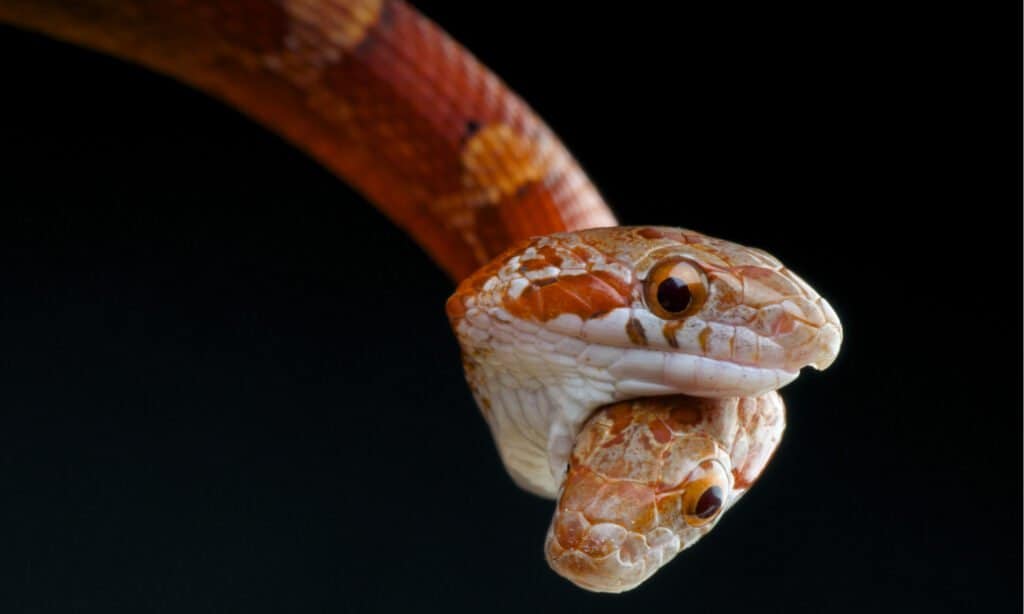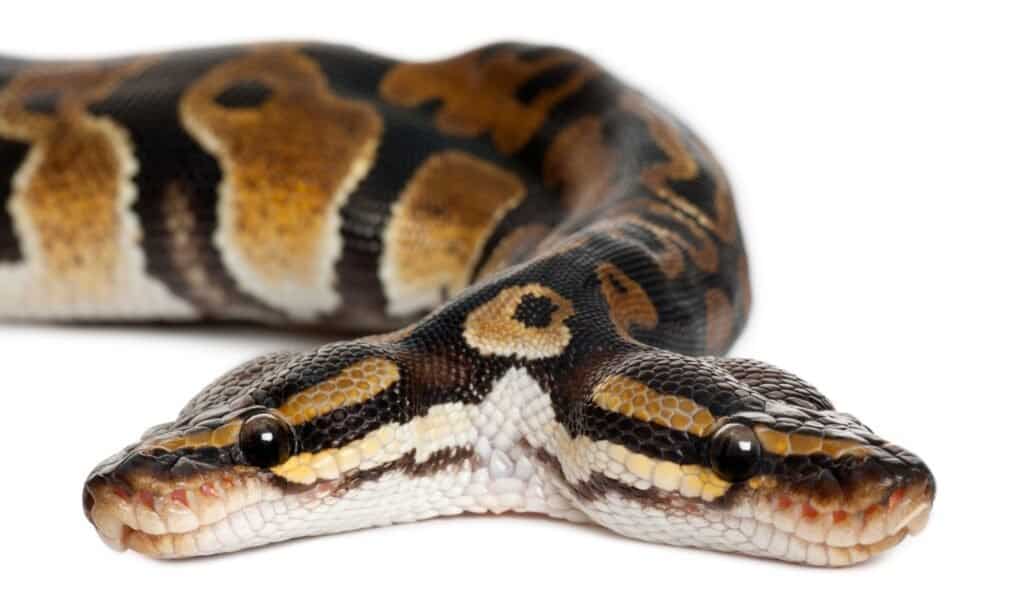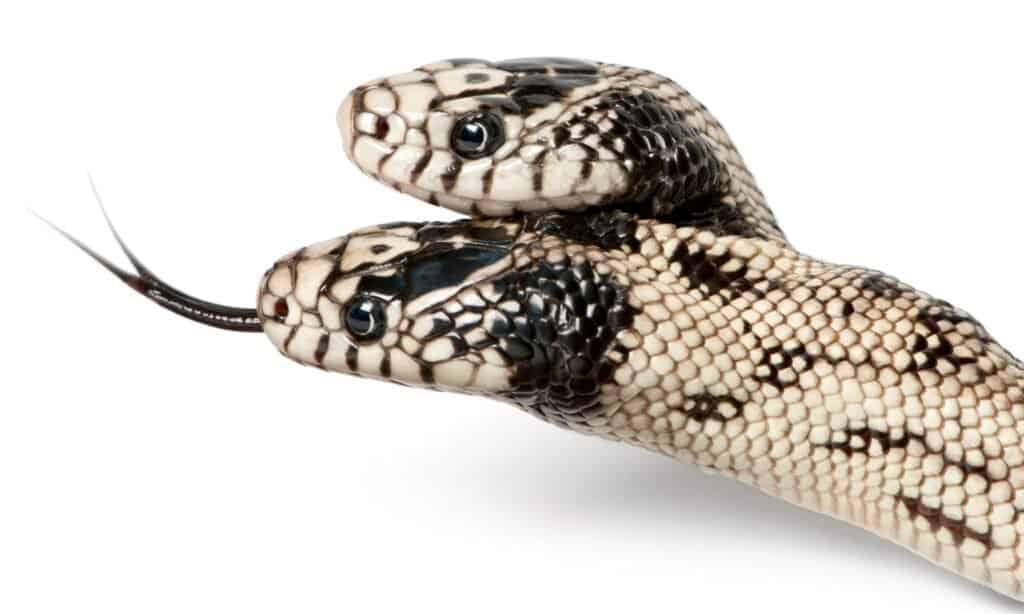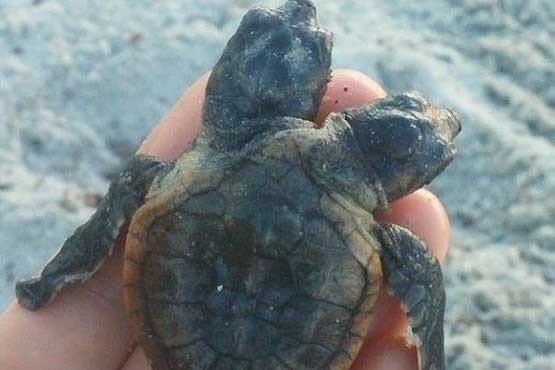Two-Headed Snakes: What Causes This and How Often Does it Occur?
Two-headed snakes may sound like something out of a Greek myth, but incredibly, this strange genetic mutation happens even to this day! Bicephaly, the scientific name for having two heads, is an interesting disease, and it has represented quite a lot in mythology and history. Let’s take a deep dive and explore: What causes two-headed snakes?
What is having two heads called?

reptiles4all/Shutterstock.com
People have known that some animals are born with two heads for quite some time now. It’s a strange and rare event, and as such, humans have mythologized it ever since they first saw it. Today, we have learned quite a bit more about this strange event known as bicephaly. Bicephaly breaks down into two pieces, “bi,” meaning two, and “cephaly,” meaning head. Altogether and we see why it’s been named as such.
To this day, the event is so rare that almost every known occurrence gets some sort of news coverage. While we know quite a bit about how this happens, there is still some mystery surrounding bicephaly as a whole. Let’s take a look into what actually causes it.
How does bicephaly happen?

GlobalP/Shutterstock.com
Bicephaly, and its broader term, polycephaly (multiple heads), is extremely rare in the animal kingdom. Still, it does happen, although there are still some things that we are learning about it.
The first possible cause of bicephaly is through the incomplete splitting of an embryo. When this happens internally, most mammals will spontaneously trigger an abortion, or miscarriage. This mostly comes from the fact that the genetic survival strategy of mammals is quality over quantity, and when a mammal’s body does a genetic “check” on the embryo, certain developmental issues will trigger an end to the pregnancy.
For snakes, however, this mechanism isn’t nearly as sensitive. Since snakes are more about numbers than they are about personally raising their young, these biological “checks” don’t happen like they do in humans. Additionally, once a snake lays an egg, the development of the embryo is mostly out of the snake’s control, and the eggs are much more susceptible to environmental factors that could trigger a spontaneous split. Essentially, it’s much more likely to happen to a reptile than it is to a mammal.
Additionally, certain environmental factors seem to increase the chances of polycephaly across animals of different species. Radiation, temperature, and chemical poisoning or toxicity are likely contributors to genetic variations and problems.
Can an animal live with two heads?

iStock.com/GlobalP
When these events happen, it is almost always to the detriment of the animal it happened to. Although we can’t be certain about numbers, it is likely that most animals with cases of polycephaly don’t make it long in the wild. Additionally, the way that the split happens is important. For example, two heads that fight over prey and have different stomachs are more likely to starve than a single snake. Also, if the split causes certain organs to come under double the stress that it was designed to (a single heart pumping for two bodies, for example), it could also reduce the lifespan of the animal.
The best chance that an animal with polycephaly has to survive is for it to be born into captivity. Under human care, there have been quite a few examples of animals, especially snakes, living with multiple heads for decades. For example, a two-headed rat snake was found by Dr. Gordon Burghardt and was studied for over 20 years.
So, in short, yes, it’s possible for a snake with two heads to live long lives, although it is less likely. The best-case scenario for a snake born with polycephaly is for it to have a minimal genetic change that could result in extra bodily stress, and for that snake to be born into human captivity.
Are there two snakes, or just one snake with two heads?

Rezaeir28 / Creative Commons – License
Some questions are difficult to answer, even with the tools of science. In this case, the question of whether a snake with two heads is a single snake or two snakes sharing one body has some factors that complicate things.
Over the course of human history, this question has been addressed through the lens of consciousness, and through the lens of philosophy and religion. In regards to consciousness, it’s usually easy to tell if a human has consciousness or not, at least in regards to conjoined twins. Most people would recognize brain activity as a separate being, even if they share every other organ. In Catechism, a theological book written by Petro Mohyla (an Eastern Orthodox theologian), it was written:
Should there be distinct heads and distinct chests, this means there are separate people each of whom must be baptised normally; if the heads and chests aren’t completely distinct from each other, however, one person must be baptised normally but baptism of the other(s) should be precluded by the formula “if not already baptised”.
St. Peter Mogila, Catechism
In short, most humans consider a two-headed snake to be one snake with two heads, but it’s more of an arbitrary line than anything else.
What other animals have been recorded with bicephaly?

William Warby / flickr – License
Aside from snakes, there have been many other recorded examples of animals displaying polycephaly. Here is a list of all the documented animals:
- humans
- cats
- snakes
- cattle
- pigs
- goats
- sheep
- turtles
- sharks
- fish
- birds
- choristodera (extinct reptile)
What did bicephaly symbolize across human history?
In modern times, we usually recognize this event as a genetic anomaly. During ancient times, however, it was a much bigger deal. In some civilizations, the two-headed snake was a symbol of rebirth, while others considered it an example of the duality of life and death.
One example of a two-headed snake in ancient art is the Double-headed serpent statue from the ancient Aztecs. It is made of turquoise, spiny oyster shell, and conch.
Discover the “Monster” Snake 5X Bigger than an Anaconda
Every day A-Z Animals sends out some of the most incredible facts in the world from our free newsletter. Want to discover the 10 most beautiful snakes in the world, a “snake island” where you’re never more than 3 feet from danger, or a “monster” snake 5X larger than an anaconda? Then sign up right now and you’ll start receiving our daily newsletter absolutely free.
More from A-Z Animals
Two-headed snakes may sound like something out of a Greek myth, but incredibly, this strange genetic mutation happens even to this day! Bicephaly, the scientific name for having two heads, is an interesting disease, and it has represented quite a lot in mythology and history. Let’s take a deep dive and explore: What causes two-headed snakes?
What is having two heads called?

reptiles4all/Shutterstock.com
People have known that some animals are born with two heads for quite some time now. It’s a strange and rare event, and as such, humans have mythologized it ever since they first saw it. Today, we have learned quite a bit more about this strange event known as bicephaly. Bicephaly breaks down into two pieces, “bi,” meaning two, and “cephaly,” meaning head. Altogether and we see why it’s been named as such.
To this day, the event is so rare that almost every known occurrence gets some sort of news coverage. While we know quite a bit about how this happens, there is still some mystery surrounding bicephaly as a whole. Let’s take a look into what actually causes it.
How does bicephaly happen?

GlobalP/Shutterstock.com
Bicephaly, and its broader term, polycephaly (multiple heads), is extremely rare in the animal kingdom. Still, it does happen, although there are still some things that we are learning about it.
The first possible cause of bicephaly is through the incomplete splitting of an embryo. When this happens internally, most mammals will spontaneously trigger an abortion, or miscarriage. This mostly comes from the fact that the genetic survival strategy of mammals is quality over quantity, and when a mammal’s body does a genetic “check” on the embryo, certain developmental issues will trigger an end to the pregnancy.
For snakes, however, this mechanism isn’t nearly as sensitive. Since snakes are more about numbers than they are about personally raising their young, these biological “checks” don’t happen like they do in humans. Additionally, once a snake lays an egg, the development of the embryo is mostly out of the snake’s control, and the eggs are much more susceptible to environmental factors that could trigger a spontaneous split. Essentially, it’s much more likely to happen to a reptile than it is to a mammal.
Additionally, certain environmental factors seem to increase the chances of polycephaly across animals of different species. Radiation, temperature, and chemical poisoning or toxicity are likely contributors to genetic variations and problems.
Can an animal live with two heads?

iStock.com/GlobalP
When these events happen, it is almost always to the detriment of the animal it happened to. Although we can’t be certain about numbers, it is likely that most animals with cases of polycephaly don’t make it long in the wild. Additionally, the way that the split happens is important. For example, two heads that fight over prey and have different stomachs are more likely to starve than a single snake. Also, if the split causes certain organs to come under double the stress that it was designed to (a single heart pumping for two bodies, for example), it could also reduce the lifespan of the animal.
The best chance that an animal with polycephaly has to survive is for it to be born into captivity. Under human care, there have been quite a few examples of animals, especially snakes, living with multiple heads for decades. For example, a two-headed rat snake was found by Dr. Gordon Burghardt and was studied for over 20 years.
So, in short, yes, it’s possible for a snake with two heads to live long lives, although it is less likely. The best-case scenario for a snake born with polycephaly is for it to have a minimal genetic change that could result in extra bodily stress, and for that snake to be born into human captivity.
Are there two snakes, or just one snake with two heads?

Rezaeir28 / Creative Commons – License
Some questions are difficult to answer, even with the tools of science. In this case, the question of whether a snake with two heads is a single snake or two snakes sharing one body has some factors that complicate things.
Over the course of human history, this question has been addressed through the lens of consciousness, and through the lens of philosophy and religion. In regards to consciousness, it’s usually easy to tell if a human has consciousness or not, at least in regards to conjoined twins. Most people would recognize brain activity as a separate being, even if they share every other organ. In Catechism, a theological book written by Petro Mohyla (an Eastern Orthodox theologian), it was written:
Should there be distinct heads and distinct chests, this means there are separate people each of whom must be baptised normally; if the heads and chests aren’t completely distinct from each other, however, one person must be baptised normally but baptism of the other(s) should be precluded by the formula “if not already baptised”.
St. Peter Mogila, Catechism
In short, most humans consider a two-headed snake to be one snake with two heads, but it’s more of an arbitrary line than anything else.
What other animals have been recorded with bicephaly?

William Warby / flickr – License
Aside from snakes, there have been many other recorded examples of animals displaying polycephaly. Here is a list of all the documented animals:
- humans
- cats
- snakes
- cattle
- pigs
- goats
- sheep
- turtles
- sharks
- fish
- birds
- choristodera (extinct reptile)
What did bicephaly symbolize across human history?
In modern times, we usually recognize this event as a genetic anomaly. During ancient times, however, it was a much bigger deal. In some civilizations, the two-headed snake was a symbol of rebirth, while others considered it an example of the duality of life and death.
One example of a two-headed snake in ancient art is the Double-headed serpent statue from the ancient Aztecs. It is made of turquoise, spiny oyster shell, and conch.
Discover the “Monster” Snake 5X Bigger than an Anaconda
Every day A-Z Animals sends out some of the most incredible facts in the world from our free newsletter. Want to discover the 10 most beautiful snakes in the world, a “snake island” where you’re never more than 3 feet from danger, or a “monster” snake 5X larger than an anaconda? Then sign up right now and you’ll start receiving our daily newsletter absolutely free.







